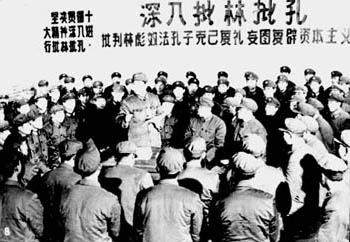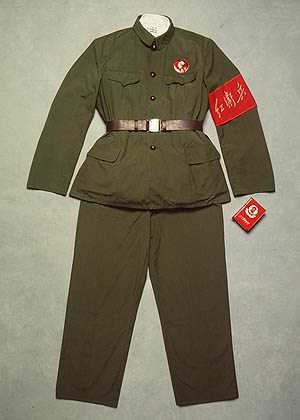|
The
Great Proletarian Cultural Revolution was a mass movement
launched in 1966, to remould society and reactivate
Communist ideals. Ultimately however, it was little
more than a power struggle between Mao Zedong, Chairman
of the Communist Party and his political rivals. For
many it signified a loss of tradition, and a loss of
their career, hope and trust. Many people lost their
lives.
Traditional
dress was categorised as one of the Four Olds:
- old
ideas
- old
culture
- old
customs
- old
habits.
Western
suits, ties and dresses were confiscated and many owners
were denounced and physically abused for their so-called
bourgeois past.
During
the Cultural Revolution many civilians wore khaki military
clothing to demonstrate their revolutionary allegiance.
The majority dressed in sympathy with the proletariat
as concern with personal appearance was regarded as
a sign of spiritual corruption and an expression of
a bourgeois past.
Many
wore patched garments, some through necessity and others
through political fervour. During the endless political
campaigns many people suffered great hardship.

Lin Biao and Confucious Criticism
movement, early 1970s.
Powerhouse
Museum collection. |

Wedding outfit: This red
cotton velvet jacket (xiao'ao) was purchased
in March 1977 by a 26-year-old actor for her wedding
dress. It was worn with blue trousers and black
leather shoes. The jacket was made by the Cultural
Revolution Clothing Factory in Peking, though the
Cultural Revolution had ended. Most couples who
married at this time wore uniforms (zhifu).
This traditional-style red velvet garment was considered
bourgeois. Powerhouse Museum collection. 98/126/54.
Photo by Sue Stafford. |
Red
Guards
Red Guards were young revolutionary activists - a powerful
and destructive political force during the Cultural
Revolution. They wore army-style uniforms, red armbands
and carried a book of Mao's quotations. Between 1966
and 1968, under the guidance of Mao Zedong, they were
dedicated to eliminating people who were perceived to
deviate from his teachings. Houses were ransacked and
gold, silver and art objects were stolen.

Red Guard outfit from the Cultural
Revolution 1966-76.
Red Guards wore national-defence green army-style
uniforms. The inspiration for the uniform came from
Mao Zedong, who wore it in 1966 at the first rally
of Red Guards in Tiananmen Square. Powerhouse Museum
collection. 98/126/18.
Photo by Sue Stafford. |
These
photographs below were taken by Roger Whittaker when
he was a student at the University of Sydney, during
two month-long trips to China in 1967 and 1968. The
tours were organised by the Australian Union of University
Students.
Few
groups were granted permission to visit China during
the Cultural Revolution (1966-76). These photographs
provide a unique view of that period. Roger Whittaker
is now an independent film producer. In 1970 he and
Bob Reece produced a documentary: China - the red
sons.

Red Guard march: During the
Cultural Revolution politically motivated marches
and denunciations were common. In this photograph
the Australian student group joins a Red Guard march.
Many of the participants are wearing Red Guard armbands
that identify their particular faction. The frontline
participants hold high the image of Mao Zedong,
Chairman of the People's Republic of China. The
slogan painted on the factory wall reads 'Long live
the thought of Chairman Mao!'.
* Print from 35 mm colour slide, by Roger Whittaker,
1967. Courtesy: Roger Whittaker Media P/L.
Powerhouse
Museum collection. |

Mao
is everywhere: Large painted portraits and statues
of Mao Zedong were erected in public places all
over China. This photograph was taken at the Summer
Palace (Yi he yuan) in Peking. Mao towers over the
people and is depicted in a god-like guise.
Some
people wear white cloth face masks (kouzhao)
to prevent them spreading germs and sickness during
winter.
* Print from 35 mm colour slide, by Roger Whittaker,
1967-68. Courtesy: Roger Whittaker Media P/L.
Powerhouse
Museum collection.
|
The
end of the Cultural Revolution
On 27 July 1968 the army was brought in to disband the
Red Guards and to attempt to regain control of the country.
The Cultural Revolution officially ended in 1976. In
1981 the Communist Party of China denounced this period
as a grave error.
|